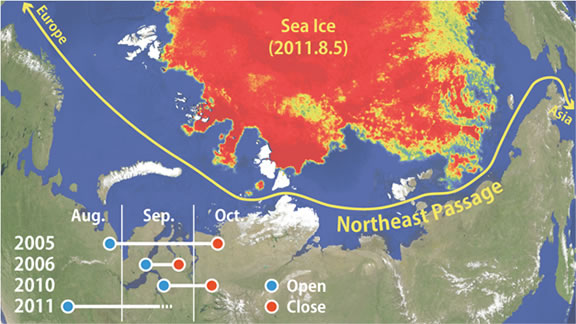2011.08.08
Weathernews Global Ice Center Report:
Fastest Polar Route Opening in History
Arctic sea ice receding at a rapid pace
The Global Ice Center at Weathernews Inc. (Tokyo, Japan CEO: Chihito Kusabiraki) has reported that the record-breaking pace of ice receding in the Arctic sea will allow commercial vessels to transit via the Polar Route from August 5th. This is a month earlier than in previous years. The northeastern passage of the Polar Route connects Asia and Europe, making faster and cheaper voyages possible when compared with the traditional routes via the Suez Canal or the Cape of Good Hope. This report is the first of the season from the Global Ice Center, and will be updated with the latest information weekly on the Global Ice Center website. http://weathernews.com/GIC/
 Current ice conditions along the Northern Polar Route and previous years
Current ice conditions along the Northern Polar Route and previous yearsIn recent years, the effects of global climate change have resulted in a trend of receding ice in the Arctic, making it possible for business enterprises to development region as a source of natural resources and shipping route. When a Polar Route opens, a voyage from Asia to Europe can be sailed in two-thirds of the distance of a typical route via the Suez canal or Cape of Good Hope. This will have a great impact on global transportation logistics. At the Weathernews Global Ice Center (GIC), data and observations from around the world are analyzed and forecast in order to provide real-time monitoring of the effects of global climate change on polar ice for advisory to the shipping industry and support for voyages via the Polar Route. Also from next year Weathernews will begin high-accuracy monitoring following the launch of the WNI Nano Satellite.
As with previous years, the GIC has observed a recurring pattern of ice receding in the summer and spreading in the winter in the Arctic sea. There is an observable a trend toward less and less ice coverage every year. This trend has been remarkable over the last few years, and is thought to be the result of global temperature changes.
This summer, sea ice is receding at a fast pace. According to the GIC analysis, the average ice coverage for July 2011 was 7.03 million square kilometers, which is the smallest area ever recorded. The particular characteristics of sea ice this year are continued melting in the Eastern Hemisphere north of Russia. Satellite data confirms that sea ice remaining on the Russian coast melted on September 8th, opening the northeastern passage on both sides. This is the second consecutive year that the Polar Route has opened and the fourth in recorded history. Until now, the route has opened from late-August until mid-September. 2011 marks the first year it has opened in early August.
The reasons for the ice receding this year are: 1) long term trend of increasing air and sea temperature, and 2) winds in the arctic that affect the flow of sea ice. The result is a quickening pattern of melting. In particular, we have seen a trend of ice breaking up along the northeastern passage through the Laptev Sea from winter to summer. The increased possibility of thinner than usual ice spreading means it will continue to melt for a longer period in the summer when compared with previous years, according to our predictions based on the data available up until April.*
*Based on analysis by Tokyo University: http://www.1.k.u-tokyo.ac.jp/YKWP/2011arctic.html
Our forecast for the remainder of August shows even more sea ice receding and further opening of the northeastern passage. Next month, we may see an even less sea ice than observed in 2007. For more information, please check the Arctic Sea Weekly Report at: http://weathernews.com/GIC/

